Integrating Construction and Operation of Large Interorganizational Projects Based on Resource Orchestration: A Case Study of Shanghai Airports
Abstract
1. Introduction
- (i)
- How can different phases of the ICO in LIPs be identified from a resource perspective?
- (ii)
- What are the key resource orchestration priorities at different stages of an LIP?
- (iii)
- How can LIPs dynamically adjust resource orchestration based on external demands?
2. Literature Review
2.1. Conceptual Research on ICO
2.2. Resource Orchestration Theory
2.3. ICO and Resource Integration in LIPs
3. Research Design
3.1. Research Methodology
3.2. Case Selection
- (i)
- Shanghai Airport Group demonstrates both typicality and uniqueness in the ICO. Firstly, the construction of Pudong and Hongqiao Airports was managed by the Shanghai Airport Construction Command, while operations were handled by their respective airport companies, making this a typical LIP. Moreover, Shanghai Airport Group identified the issue of construction–operation separation as early as 1999 and pioneered the “operation-oriented construction” concept in 2005, positioning itself as an industry leader. Secondly, the Group has implemented several innovative practices to promote the ICO, such as “design review” and “operation-front-end comprehensive debugging”, which have provided valuable insights to the industry. Thirdly, Shanghai Airports has accumulated extensive experience through multiple expansion projects and has continuously applied the ICO principles. Lastly, the Group has achieved significant outcomes, exemplified by the Hongqiao T1 Expansion Project, which received the “United Nations Global Green Solutions Gold Award”.
- (ii)
- The case selection follows the principle of theoretical sampling [57], ensuring typicality and relevance. Shanghai Airports’ ICO practice has evolved through stages of “confusion, exploration, improvement, and perfection”. While navigating challenges through trial and error, the Group has consistently strengthened top-level design, embedding scientific management concepts, methodologies, and mechanisms into all stages of project construction. This has led to continuous optimization of costs and benefits, garnering widespread recognition and praise. Therefore, selecting Shanghai Airports as a case study provides an excellent example for investigating how LIPs can achieve systematic integration between construction and operation stakeholders.
- (iii)
- The feasibility of selecting Shanghai Airport Group as a case study is well justified. The research team has maintained long-term collaboration with Shanghai Airport Group since the commencement of Pudong Airport’s construction in 1997, allowing for a deep understanding of the Group’s ICO practices, including fundamental aspects and key events. In addition, the team conducted targeted research and interviews with Shanghai Airports, other stakeholder companies, and experts. The interviewees included employees at all levels—junior, mid-level, and senior management—as well as industry experts with rich theoretical and practical experience. This solid information base supports an in-depth exploration of the ICO evolution, the identification of critical issues and key stages in the process, and the refinement of theoretical innovations.
3.3. Data Collection and Analysis
3.3.1. Data Collection
3.3.2. Data Analysis
4. Case Study
4.1. Case Overview
4.2. Case Analysis
4.2.1. Synergy Period (2005–2013)
4.2.2. Integration Period (2014–2018)
4.2.3. Integration Period (2019–Present)
5. Research Findings
6. Conclusions
6.1. Theoretical Contributions
6.2. Practical Implications
- (i)
- Strengthening Information Transmission and Communication Mechanisms
- (ii)
- The Critical Role of Innovation in ICO
6.3. Limitations and Future Research Directions
- (i)
- Generality of Findings
- (ii)
- Theoretical Scope of Resource Orchestration
Author Contributions
Funding
Data Availability Statement
Conflicts of Interest
References
- Zhang, X.; Denicol, J.; Chan, P.; Le, Y. Designing the Transition to Operations in Large Inter-Organizational Projects: Strategy, Structure, Process, and People. J. Oper. Manag. 2024, 70, 107–136. [Google Scholar] [CrossRef]
- Li, Q.; Li, Q.; Wu, J.; Li, X.; Li, H.; Cheng, Y. Wellhead Stability during Development Process of Hydrate Reservoir in the Northern South China Sea: Evolution and Mechanism. Processes 2024, 13, 40. [Google Scholar] [CrossRef]
- Li, Q.; Li, Q.; Cao, H.; Wu, J.; Wang, F.; Wang, Y. The Crack Propagation Behaviour of CO2 Fracturing Fluid in Unconventional Low Permeability Reservoirs: Factor Analysis and Mechanism Revelation. Processes 2025, 13, 159. [Google Scholar] [CrossRef]
- Al-Mazrouie, J.R.; Ojiako, U.; Williams, T.; Chipulu, M.; Marshall, A. An operations readiness typology for mitigating against transitional ‘disastrous openings’ of airport infrastructure projects. Prod. Plan. Control. 2021, 32, 283–302. [Google Scholar] [CrossRef]
- Laursen, M.; Svejvig, P. Taking stock of project value creation: A structured literature review with future directions for research and practice. Int. J. Proj. Manag. 2016, 34, 736–747. [Google Scholar] [CrossRef]
- Zerjav, V. Why do business organizations participate in projects? Toward a typology of project value domains. Proj. Manag. J. 2021, 52, 287–297. [Google Scholar] [CrossRef]
- Dodgson, M.; Gann, D.; MacAulay, S.; Davies, A. Innovation strategy in new transportation systems: The case of Crossrail. Transp. Res. Part A Policy Pract. 2015, 77, 261–275. [Google Scholar] [CrossRef]
- Slack, N.; Brandon-Jones, A. Operations Management, 9th ed.; Pearson Education: London, UK, 2019. [Google Scholar]
- Zhang, W.J.; Wang, J.W. Design Theory and Methodology for Enterprise Systems. Enterp. Inf. Syst. 2016, 10, 245–248. [Google Scholar] [CrossRef]
- Zhang, W.J.; Wang, J.W.; Lin, Y. Integrated Design and Operation Management for Enterprise Systems. Enterp. Inf. Syst. 2019, 13, 424–429. [Google Scholar] [CrossRef]
- Morgan, M.; Malek, W.A.; Levitt, R.E. Executing Your Strategy; Harvard Business School Press: Harvard, MA, USA, 2008. [Google Scholar]
- Locatelli, G.; Zerjav, V.; Klein, G. Project transitions—Navigating across strategy, delivery, use, and decommissioning. Proj. Manag. J. 2020, 51, 467–473. [Google Scholar] [CrossRef]
- Smyth, H. Projects and programmes: Diversity of management, diversity of aims and interests. Int. J. Proj. Manag. 2009, 27, 97–100. [Google Scholar] [CrossRef]
- Thiry, M. Combining value and project management into an effective programme management model. Int. J. Proj. Manag. 2002, 20, 221–227. [Google Scholar] [CrossRef]
- Pellegrinelli, S. What’s in a name: Project or programme? Int. J. Proj. Manag. 2011, 29, 232–240. [Google Scholar] [CrossRef]
- Shi, Y. Application of the integrated building and operation project management model in aviation fuel engineering. Civ. Aviat. Manag. 2023, 12, 80–83. [Google Scholar]
- Xu, Z.; Lee, D.H.; Ahn, J.W. Design and Operation Characteristics of a Novel Switched Reluctance Motor with a Segmental Rotor. IEEE Trans. Ind. Appl. 2016, 52, 2564–2572. [Google Scholar] [CrossRef]
- Nie, Y. Large new airport projects: Strategic human resource management. Civ. Aviat. Manag. 2015, 7, 58–63. [Google Scholar]
- Li, J. Airport construction should carry out integration of construction and operation. Civ. Aviat. Manag. 2018, 10, 61–63. [Google Scholar]
- Xu, Q. Global trends and China’s strategy for the integration of construction and operation of infrastructure projects. J. Int. Econ. Coop. 2015, 10, 6. [Google Scholar]
- Du, Q.; Cheng, D. Main risks and countermeasures of the “investment, construction, and operation integration” model for Chinese enterprises overseas. Macroeconomics 2020, 10, 10. [Google Scholar]
- Kong, F.; Tan, J. Construction and implementation paths of the “integrated” system with design, construction and operation for large stadiums in China. J. Phys. Educ. 2021, 28, 47–53. [Google Scholar]
- Wernerfelt, B. Resource-Based View of the Firm. Strateg. Manag. J. 1984, 5, 171–180. [Google Scholar] [CrossRef]
- Helfat, C.E.; Finkelstein, S.; Mitchell, W.; Peteraf, M.; Singh, H.; Teece, D.; Winter, S.G. Dynamic Capabilities: Understanding Strategic Change in Organizations; John Wiley & Sons: Hoboken, NJ, USA, 2009. [Google Scholar]
- Sirmon, D.G.; Hitt, M.A.; Ireland, R.D. Managing Firm Resources in Dynamic Environments to Create Value: Looking Inside the Black Box. Acad. Manag. Rev. 2007, 32, 273–292. [Google Scholar] [CrossRef]
- Sirmon, D.G.; Hitt, M.A.; Arregle, J.; Campbell, J.T. Capability Strengths and Weaknesses in Dynamic Markets: Investigating the Bases of Temporary Competitive Advantage. Strateg. Manag. J. 2010, 31, 1386–1409. [Google Scholar] [CrossRef]
- Zhang, Q.; Hua, Z. Review of Resource Orchestration Theory and Its Research Progress. Bus. Manag. J. 2020, 9, 193–208. [Google Scholar] [CrossRef]
- Song, H.; Han, M.; Hu, X. How Does Supply Chain Finance Boost the Low-carbon Development of Supply Chain? A Case Study Based on the Innovation Practice of State Grid Yingda. J. Manag. World 2023, 5, 93–112. [Google Scholar] [CrossRef]
- Miao, C.; Coombs, J.E.; Qian, S.; Sirmon, D.G. The mediating role of entrepreneurial orientation: A meta-analysis of resource orchestration and cultural contingencies. J. Bus. Res. 2017, 77, 68–80. [Google Scholar] [CrossRef]
- Morrow, J.L.; Sirmon, D.G.; Hitt, M.A.; Holcomb, T.R. Creating value in the face of declining performance: Firm strategies and organizational recovery. Strateg. Manag. J. 2007, 28, 271–283. [Google Scholar] [CrossRef]
- Hanks, S.H.; Watson, C.J.; Jansen, E.; Chandler, G.N. Tightening the life-cycle construct: A taxonomic study of growth stage configurations in high-technology organizations. Entrep. Theory Pract. 1994, 18, 5–29. [Google Scholar] [CrossRef]
- Bakker, R.M. Taking stock of temporary organizational forms: A systematic review and research agenda. Int. J. Manag. Rev. 2010, 12, 466–486. [Google Scholar] [CrossRef]
- Jones, C.; Lichtenstein, B.B. The Oxford Handbook of Inter-Organizational Relations; Oxford University Press: Oxford, UK, 2008. [Google Scholar]
- Ligthart, R.; Oerlemans, L.; Noorderhaven, N. In the shadows of time: A case study of flexibility behaviors in an inter-organizational project. Organ. Stud. 2016, 37, 1721–1743. [Google Scholar] [CrossRef]
- Lundin, R.A.; Söderholm, A. A theory of the temporary organization. Scand. J. Manag. 1995, 11, 437–455. [Google Scholar] [CrossRef]
- Ruuska, I.; Ahola, T.; Artto, K.; Locatelli, G.; Mancini, M. A new governance approach for multi-firm projects: Lessons from Olkiluoto 3 and Flamanville 3 nuclear power plant projects. Int. J. Proj. Manag. 2011, 29, 647–660. [Google Scholar] [CrossRef]
- Zhang, K.-B.; Liu, G.-Y.; Liu, T.; Tian, Y.-Z.; Wang, Y.; Wei, P.; Wu, H. Countermeasures on the integration of transport airport planning, construction and operations. Civ. Aviat. Manag. 2023, 2, 56–60. [Google Scholar]
- Zhao, Z. Research on Information System of the Integrative Management of Expressway Construction and Maintenance. Ph.D. Thesis, Tianjin University, Tianjin, China, 2008. [Google Scholar]
- Hu, Z.-Z.; Zhang, J.-P.; Yu, F.-Q.; Tian, P.-L.; Xiang, X.-S. Construction and facility management of large MEP projects using a multi-scale building information model. Adv. Eng. Softw. 2016, 100, 215–230. [Google Scholar] [CrossRef]
- Song, K.; Cui, H. Thoughts on integration of civil airport construction and operation. Civ. Aviat. Manag. 2015, 10, 42–44. [Google Scholar]
- Potkany, M.; Vetrakova, M.; Babiakova, M. Facility management and its importance in the analysis of building life cycle. Procedia Econ. Financ. 2015, 26, 202–208. [Google Scholar] [CrossRef]
- Chen, X.-L.; Xia, Z.-Y.; Li, Z.-M.; Ji, X.-K. Integrated Management of Airport Planning, Construction, and Safe Operation. Mod. Eng. Proj. Manag. 2024, 3, 185–187. [Google Scholar]
- Mi, L.-D.; Zeng, D.-Q.; Liu, H.; Zhang, G.-Q.; Zhang, J.-F. Development and application of Sinopec integrated management platform for underground gas storage. Pet. Reserv. Eval. Dev. 2023, 13, 781–788. [Google Scholar]
- Wang, X.-L.; Wang, X.-G.; Chen, X.; Wu, Y.; Li, Y.-R.; Meng, F.-J. Research on the Integrated Application of BIM in High-speed Railway Construction and Operation Management. Railw. Stand. Des. 2023, 10, 67. [Google Scholar]
- Oppong, G.D.; Chan, A.P.C.; Dansoh, A. A review of stakeholder management performance attributes in construction projects. Int. J. Proj. Manag. 2017, 35, 1037–1051. [Google Scholar] [CrossRef]
- Lehtinen, J.; Aaltonen, K. Organizing external stakeholder engagement in inter-organizational projects: Opening the black box. Int. J. Proj. Manag. 2020, 38, 85–98. [Google Scholar] [CrossRef]
- Banker, R.D.; Chang, H.; Kao, Y.C. Evaluating cross-organizational impacts of information technology–an empirical analysis. Eur. J. Inf. Syst. 2010, 19, 153–167. [Google Scholar] [CrossRef]
- Aubry, M.; Hobbs, B.; Thuillier, D. A new framework for understanding organisational project management through the PMO. Int. J. Proj. Manag. 2007, 25, 328–336. [Google Scholar] [CrossRef]
- Aubry, M.; Hobbs, B. Project Management Office (PMO): A Quest for Understanding; Project Management Institute: Newtown Square, PA, USA, 2010. [Google Scholar]
- Zwikael, O.; Meredith, J.R. Who’s who in the project zoo? The ten core project roles. Int. J. Oper. Prod. Manag. 2018, 38, 474–492. [Google Scholar] [CrossRef]
- Aaltonen, K.; Turkulainen, V. Institutionalization of a collaborative governance model to deliver large, inter-organizational projects. Int. J. Oper. Prod. Manag. 2022, 42, 1294–1328. [Google Scholar] [CrossRef]
- Whyte, J.; Nussbaum, T. Transition and temporalities: Spanning temporal boundaries as projects end and operations begin. Proj. Manag. J. 2020, 51, 505–521. [Google Scholar] [CrossRef]
- Denicol, J.; Davies, A.; Pryke, S. The organisational architecture of megaprojects. Int. J. Proj. Manag. 2021, 39, 339–350. [Google Scholar] [CrossRef]
- Zerjav, V.; Edkins, A.; Davies, A. Project capabilities for operational outcomes in inter-organisational settings: The case of London Heathrow Terminal 2. Int. J. Proj. Manag. 2018, 36, 444–459. [Google Scholar] [CrossRef]
- Su, J.Q.; Sun, Y.Y. Relationship among Business Cases, Teaching Cases and Research Cases. J. Manag. Case Stud. 2010, 3, 255–259. [Google Scholar]
- Yin, R.K. Case Study Research: Design and Methods, 5th ed.; Sage Publications Inc.: Thousand Oaks, CA, USA, 2014. [Google Scholar]
- Glaser, B.G.; Strauss, A.L.; Strutzel, E. The Discovery of Grounded Theory: Strategies for Qualitative Research. Nurs. Res. 1968, 17, 364. [Google Scholar] [CrossRef]
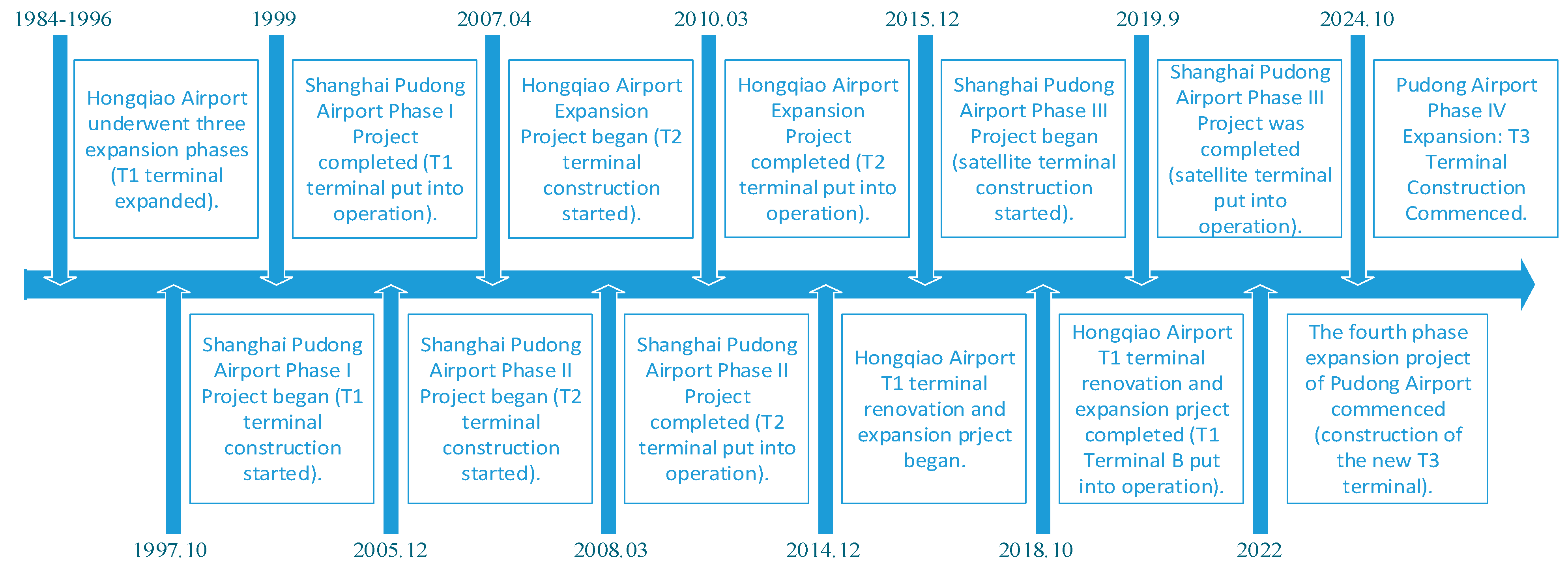
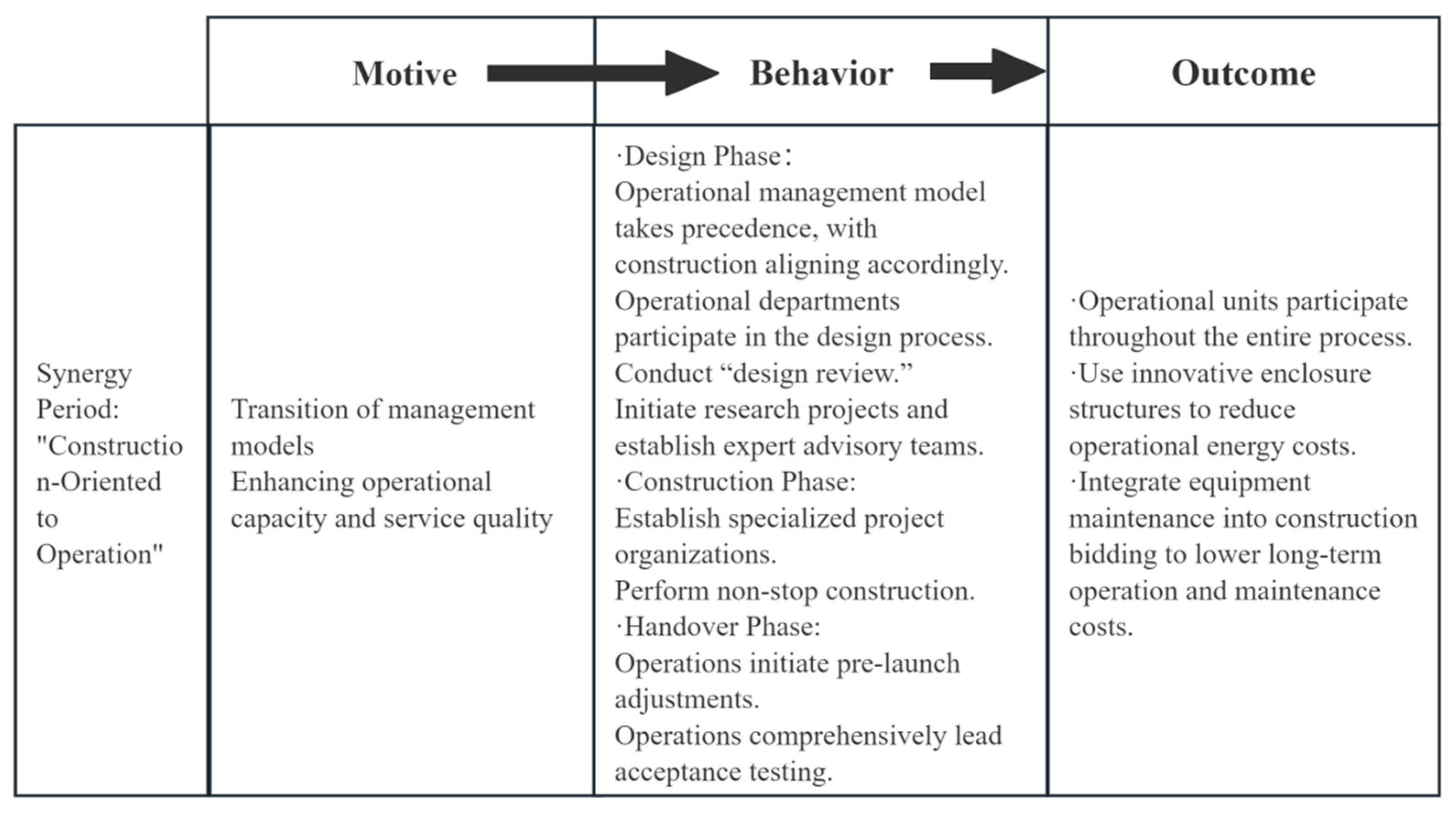
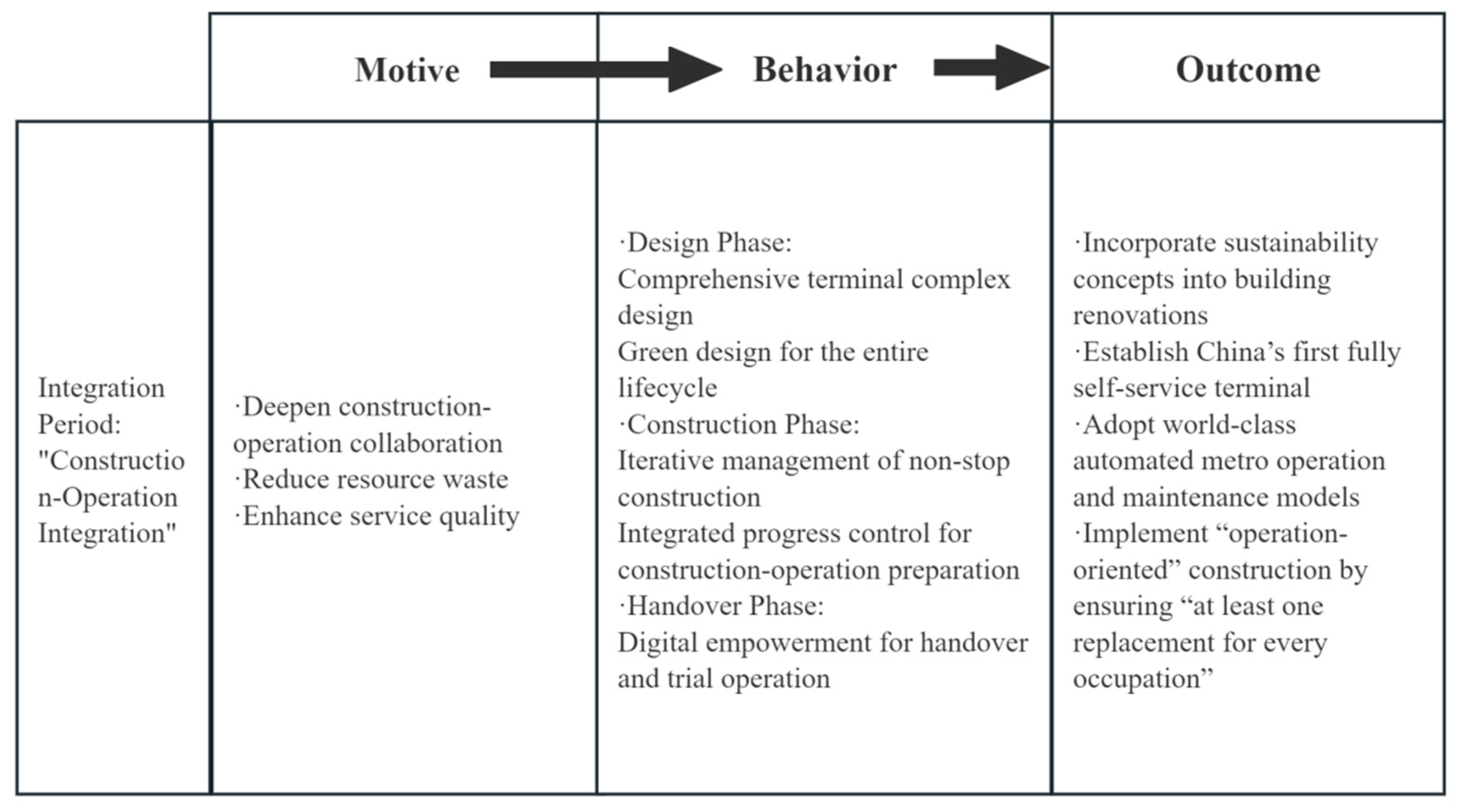
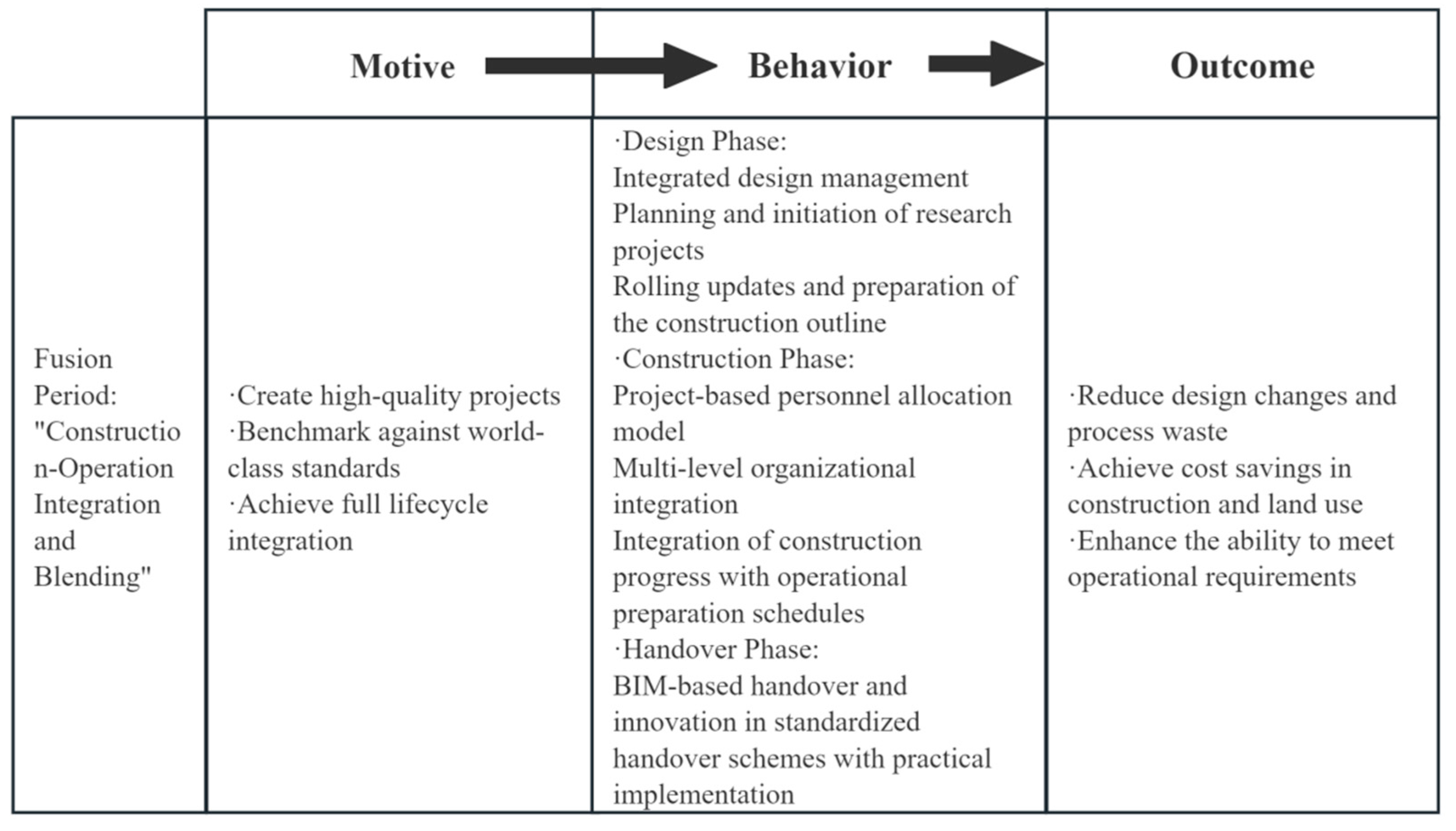
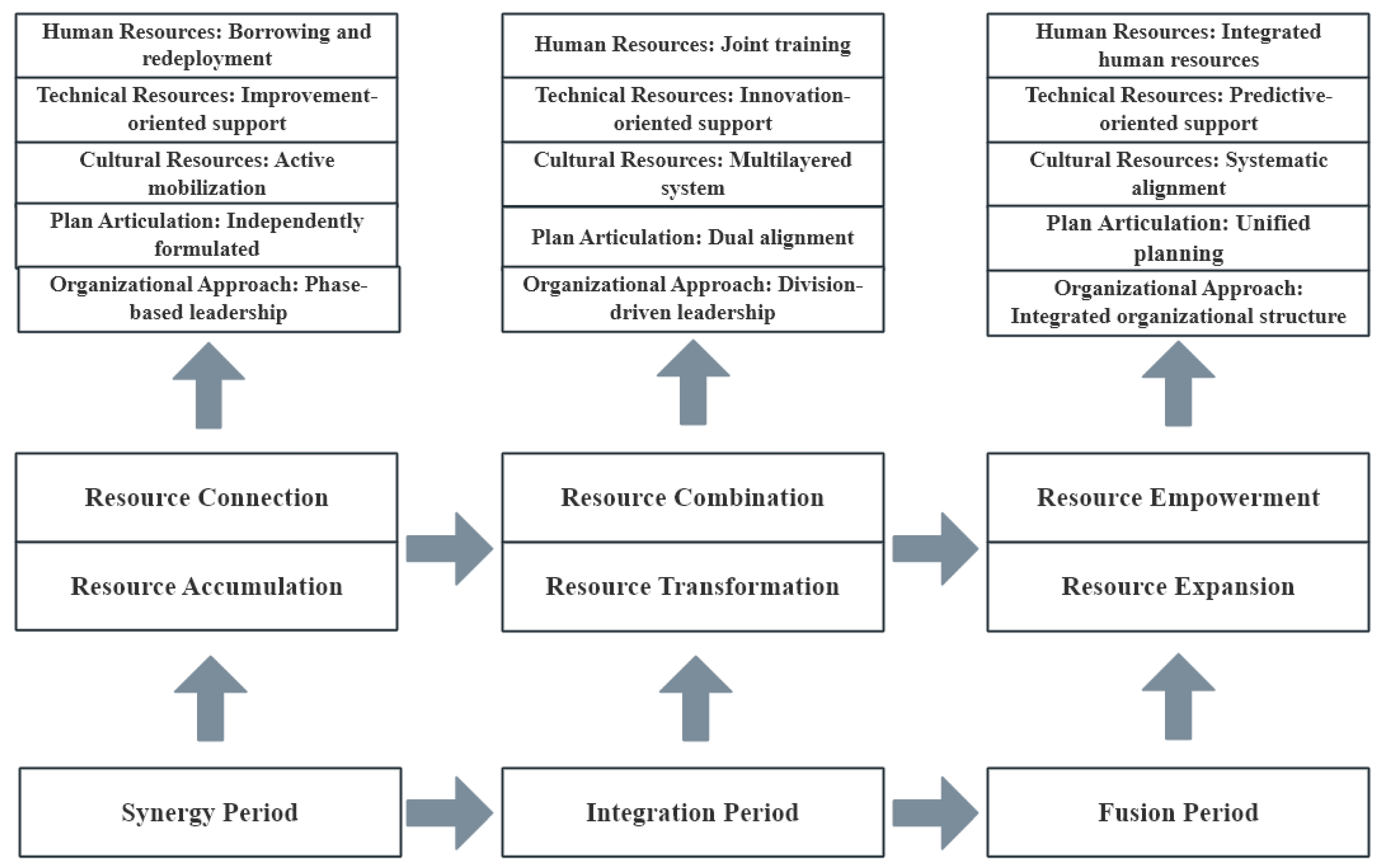
| Data Source | Data Content | |||
|---|---|---|---|---|
| Primary Interview Data | Interviewee | Interview Topic | Interview Duration | Word Count |
| Chief Engineer of Shanghai Airport Group | Evolution of ICO | 6 h | 20,000 words | |
| Leaders of the Command Department (2 people) | Experiences and practices in ICO | 4 h | 15,000 words | |
| Leaders of Pudong Airport Company (3 people) | Experiences and practices in ICO | 4 h | 12,000 words | |
| Leaders of Hongqiao Airport Company (3 people) | Experiences and practices in ICO | 4 h | 12,000 words | |
| Head of the ICO Department in the Command Unit | Work mechanisms | 16 h | 125,000 words | |
| Head of the ICO Department in Pudong Airport Company | Work mechanisms | 4.5 h | 42,000 words | |
| Engineering Management Departments of the Command Unit (e.g., Airfield and Terminal Engineering—7 people) | Practical operations in ICO | 8 h | 69,000 words | |
| Business Support Departments of the Command Unit (e.g., Design Management, Planning and Finance—7 people) | Practical operations in ICO | 10 h | 82,000 words | |
| Human Resources Department of the Command Unit (3 people) | Human resource allocation | 6 h | 45,000 words | |
| Human Resources Department of Pudong Airport Company (2 people) | Human resource allocation | 3 h | 28,000 words | |
| Human Resources Department of Hongqiao Airport Company (2 people) | Human resource allocation | 1 h | 12,000 words | |
| Human Resources Department of Shanghai Airport Group (3 people) | Human resource allocation | 1.5 h | 12,000 words | |
| Participatory Observation | Multiple on-site visits to Shanghai Airport Group, including the Construction Command Unit, Pudong Airport Company, and Hongqiao Airport Company, to understand the planning, implementation, and outcomes of ICO in various expansion and renovation projects. | |||
| Secondary Data | Internal materials provided by management (e.g., meeting minutes, specialized reports, presentation slides, and summary documents). | |||
| Publicly available resources related to the research topic obtained from Shanghai Airport Group’s official website, CNKI, and other open sources. | ||||
| Books, implementation plans, and other publications by Shanghai Airport Group regarding previous expansion and renovation projects. | ||||
| Reports, documents, and articles from authoritative media outlets such as People’s Daily and official organizational websites. | ||||
| Data Source | Data Type | Stages of ICO Evolution | Code | ||
|---|---|---|---|---|---|
| Synergy Period | Integration Period | Fusion Period | |||
| Primary Interview Data | Real-Time Data | 27 | 58 | 69 | A1 |
| Participatory Observation Data | Real-Time Data | 0 | 0 | 17 | B1 |
| Secondary Data | Retrospective Data | 16 | 25 | 32 | C1 |
| Main Period | Core Concept | Relationship Implications |
|---|---|---|
| Synergy Period | Resource Connection | Collaborate with industry-leading enterprises, research institutions, and experts to gain theoretical and practical experience in ICO, forming a network of innovative management collaborations. |
| Resource Accumulation | Establish specialized teams and working groups for ICO, strengthening collaboration in personnel, technology, and cultural resources. | |
| Integration Period | Resource Combination | Actively coordinate construction and operation teams to jointly formulate operation plans and schedules, promoting seamless integration in personnel, technology, and cultural dimensions. |
| Resource Transformation | Leverage comprehensive teams, advanced construction technology, and operational concepts to drive innovation and integration in construction–operation practices. | |
| Fusion Period | Resource Empowerment | Fully utilize human resources, digital technology, and cultural assets to create competitive advantages for the enterprise while providing reference and resource support for related industries. |
| Resource Expansion | Utilize a complete organizational structure and refined process management mechanisms to expand ICO practices into other businesses or fields. |
Disclaimer/Publisher’s Note: The statements, opinions and data contained in all publications are solely those of the individual author(s) and contributor(s) and not of MDPI and/or the editor(s). MDPI and/or the editor(s) disclaim responsibility for any injury to people or property resulting from any ideas, methods, instructions or products referred to in the content. |
© 2025 by the authors. Licensee MDPI, Basel, Switzerland. This article is an open access article distributed under the terms and conditions of the Creative Commons Attribution (CC BY) license (https://creativecommons.org/licenses/by/4.0/).
Share and Cite
Xin, C.; Shi, Q.; Xiao, C.; Shao, Y.; Liu, C. Integrating Construction and Operation of Large Interorganizational Projects Based on Resource Orchestration: A Case Study of Shanghai Airports. Buildings 2025, 15, 866. https://doi.org/10.3390/buildings15060866
Xin C, Shi Q, Xiao C, Shao Y, Liu C. Integrating Construction and Operation of Large Interorganizational Projects Based on Resource Orchestration: A Case Study of Shanghai Airports. Buildings. 2025; 15(6):866. https://doi.org/10.3390/buildings15060866
Chicago/Turabian StyleXin, Chenglin, Qian Shi, Chao Xiao, Yingcheng Shao, and Chenyu Liu. 2025. "Integrating Construction and Operation of Large Interorganizational Projects Based on Resource Orchestration: A Case Study of Shanghai Airports" Buildings 15, no. 6: 866. https://doi.org/10.3390/buildings15060866
APA StyleXin, C., Shi, Q., Xiao, C., Shao, Y., & Liu, C. (2025). Integrating Construction and Operation of Large Interorganizational Projects Based on Resource Orchestration: A Case Study of Shanghai Airports. Buildings, 15(6), 866. https://doi.org/10.3390/buildings15060866





